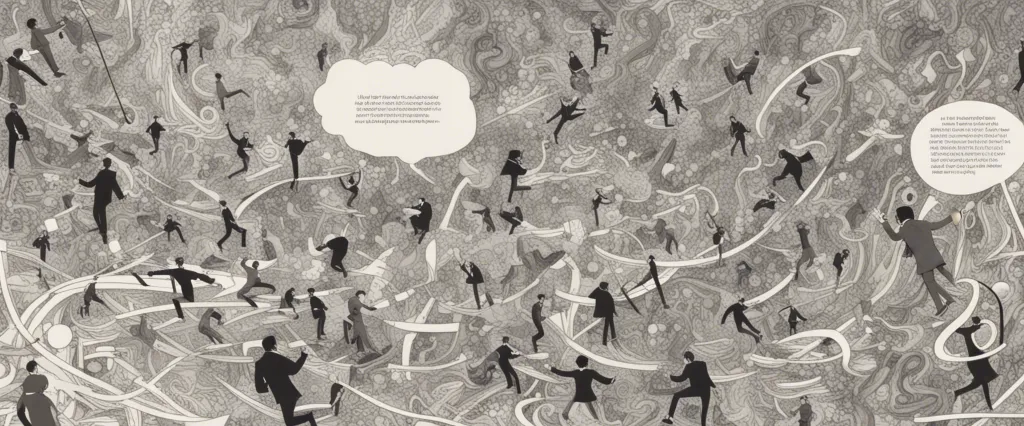In “Chaos “, James Gleick delves into the revolutionary world of chaos theory, a groundbreaking field that emerged in the late 20th century, and explores its far-reaching implications. Gleick, an American author and journalist, has effectively narrated the intriguing history and the prominent minds behind this scientific paradigm shift. He is renowned for his ability to make complex scientific concepts accessible to a wider audience, evident in his widely acclaimed works such as “Genius: The Life and Science of Richard Feynman” and “The Information: A History, a Theory, a Flood”. In his book, “Chaos”, Gleick plunges readers into the captivating realm of unpredictability and reveals how the hidden patterns of chaos are embedded in the fabric of our everyday lives.
Chapter 1: The Butterfly Effect
Chapter 1 of the book “Chaos: Making a New Science” by James Gleick is titled “The Butterfly Effect.” This chapter introduces the concept of chaos theory and explores how small, seemingly insignificant actions can have a profound impact on complex systems.
Gleick begins by describing the work of Edward Lorenz, a meteorologist who was studying weather patterns using computer simulations. In 1960, Lorenz made a groundbreaking discovery that would eventually become known as the “butterfly effect.” While trying to recreate a weather simulation, he rounded off a decimal point in his initial conditions. This minute change drastically altered the entire outcome of the simulation. Lorenz realized that even the tiniest alteration in the starting point could lead to significant differences in the patterns that emerged.
This insight challenged the fundamental belief that complex systems were predictable, assuming that all initial data were known with perfect accuracy. Lorenz’s work demonstrated that even the most thorough knowledge of initial conditions would still result in inaccuracies due to the chaotic nature of the system.
Gleick delves into the implications of this discovery by exploring other fields where chaos theory is applicable, such as biology, economics, and physics. He introduces the notion that complex phenomena arise from simple rules, yet the outcome is impossible to precisely predict. This revolutionary perspective challenges traditional deterministic approaches that assume every effect has a clear, direct cause.
In conclusion, Chapter 1 of “Chaos: Making a New Science” presents the concept of the butterfly effect, which symbolizes the sensitivity of complex systems to small changes in their initial conditions. This notion challenges the long-held belief in predictability, revealing the inherent unpredictability and complexity that underlies various fields of study.
Chapter 2: Revolution
Chapter 2 of “Chaos” by James Gleick, titled “Revolution,” delves into the historical developments that led to the emergence of chaos theory. Gleick begins by highlighting the influence of the Industrial Revolution, which brought about a mechanistic worldview focused on order and predictability. However, as the 19th century progressed, scientists began to question the limitations of this deterministic perspective.
The chapter introduces Henri Poincaré, a French mathematician who played a key role in the revolution of scientific thought. Poincaré’s work on celestial mechanics challenged the notion that the universe operated with perfect order and predictability, revealing the complex and seemingly chaotic behavior of planets and celestial bodies. This recognition paved the way for a shift to dynamic systems thinking.
Gleick also explores the contributions of two other influential figures in the development of chaos theory: the Russian physicist Alexei Lyapunov and the American mathematician Edward Lorenz. Lyapunov’s work focused on the stability of systems, establishing the concept of limit cycles and introducing the idea that even systems that appear chaotic might exhibit an underlying stability. Lorenz, on the other hand, made a groundbreaking discovery while running weather prediction models, where he observed that even the slightest changes in initial conditions could lead to drastically different outcomes—a phenomenon later popularized as the “butterfly effect.”
Throughout the chapter, Gleick emphasizes that chaos theory is not simply the study of disorder but rather the exploration of nonlinear dynamics. This revolutionary shift in scientific thinking ultimately broke away from linear cause-and-effect models and embraced the inherent unpredictability and sensitivity to initial conditions that many natural systems exhibit.
In summary, Chapter 2 of “Chaos” traces the historical progress of scientific thought leading up to the birth of chaos theory, showcasing how figures like Poincaré, Lyapunov, and Lorenz revolutionized our understanding of dynamical systems and opened the door to the study of chaos.
Chapter 3: The Lorenz Equations
Chapter 3 of the book “Chaos” by James Gleick introduces the Lorenz equations, which represent a seemingly simple mathematical model that lead to major breakthroughs in the study of chaos theory. The chapter begins by discussing Edward Lorenz, an American mathematician and meteorologist who stumbled upon these equations while working on weather prediction models.
Lorenz was attempting to create a simplified mathematical representation of fluid convection, which plays a crucial role in weather patterns. However, to make the calculations more tractable, he made certain simplifications that transformed the equations. These alterations had the unexpected consequence of revealing chaotic behavior in the system.
The chapter delves into the three interconnected differential equations that now bear Lorenz’s name. These equations describe the dynamics of a hypothetical atmosphere, focusing on three variables: temperature, motion, and density. Gleick explains how these variables influence and are influenced by each other in a complex manner.
The key insight of Lorenz’s work was the discovery of the “butterfly effect” – the idea that small alterations in initial conditions can have profound and unpredictable effects on the outcome of a system. In other words, even tiny changes in the starting values for temperature, motion, or density can lead to vastly different outcomes.
Gleick goes on to discuss how Lorenz’s equations astounded the scientific community, as they challenged the prevailing assumption that all natural systems were predictable given enough information. The chapter concludes by highlighting the long-lasting impact of the Lorenz equations, which demonstrated that even the most seemingly straightforward mathematical models can exhibit chaotic behavior and opened up new avenues for understanding the complexities of the natural world.
Chapter 4: Strange Attractors

Chapter 4 of “Chaos” by James Gleick, titled “Strange Attractors,” delves into the groundbreaking work of mathematicians such as Henri Poincaré and Edward Lorenz, who ventured into realms of chaos theory and the study of complex systems. Gleick starts by discussing Poincaré’s realization that even simple systems could exhibit unpredictability and unstable behaviors.
Poincaré’s key contribution was the discovery of what he called “strange attractors.” He found that in certain dynamical systems, trajectories never repeated exactly, but instead, they followed intricate, non-repetitive patterns within bounded regions known as attractors. These attractors provided some semblance of order within chaotic systems. Gleick then introduces Lorenz, a meteorologist who meticulously experimented with mathematical models simulating weather systems.
Lorenz stumbled upon strange attractors when he noticed that even trivial variations in initial conditions led to drastically different outcomes in his equations. This led him to the idea of the “butterfly effect,” where a small change can have a massive impact on the future state of a complex system. Gleick explores the significance of Lorenz’s discoveries and how he measured the characteristics of strange attractors, such as their fractal nature.
The chapter concludes by highlighting the implications of strange attractors and chaos theory, extending their application to fields beyond meteorology. Gleick highlights the relevance of studying chaos in fields ranging from biology to economics and emphasizes that even amidst the unpredictability and complexity, there are underlying patterns that govern such systems. Understanding these patterns and harnessing chaos theory could lead to remarkable breakthroughs in various disciplines.
In summary, Chapter 4 of “Chaos” discusses the groundbreaking work of Poincaré and Lorenz in the field of chaos theory, specifically focusing on strange attractors and their role in understanding complex systems. The chapter delves into their efforts to understand patterns within chaos and showcases the far-reaching implications of their discoveries.
Chapter 5: Universality
In Chapter 5 of “Chaos: Making a New Science” by James Gleick, titled “Universality,” the author delves into the concept of universality and how it relates to chaos theory. Universality refers to the idea that there are underlying patterns or principles that apply universally across various chaotic systems, regardless of the specific details.
Gleick begins by exploring the work of physicists and mathematicians who have studied chaotic systems in different fields, such as fluid dynamics, biological systems, and the stock market. Despite the diversity of these systems, researchers have discovered certain universal characteristics that help them understand and predict chaotic behavior.
One key concept Gleick discusses is the notion of “strange attractors,” which are stable patterns that emerge in chaotic systems. These attractors are not restricted to a specific system but can be observed in multiple domains. For example, the chaotic behavior of fluid flow can be modeled using mathematical equations that depict the same attractors found in the electrical circuits.
The author also highlights the work of Mitchell Feigenbaum, who discovered a universal value known as the Feigenbaum constant. This number provides a universal scaling factor that helps describe the behavior of chaos across different systems.
Furthermore, Gleick introduces other universal patterns found in chaotic systems, such as the fractal geometry of natural formations like coastlines and mountain ranges. Fractals exhibit self-similarity at different scales, meaning that zooming in or out reveals similar patterns.
In summary, Chapter 5 explores the universality of chaos theory, emphasizing the recurring patterns and principles observed across diverse chaotic systems. This concept provides scientists with a framework to understand and predict chaotic behavior, offering insights into various fields ranging from physics to biology and beyond.
Chapter 6: The Experimenter’s Regress
Chapter 6 of “Chaos: Making a New Science” by James Gleick, titled “The Experimenter’s Regress,” explores the challenges faced by scientists in understanding and explaining chaos theory. Gleick begins by highlighting the impact of computers on scientific experimentation, enabling scientists to conduct complex simulations and gather enormous amounts of data.
The chapter focuses on the work of Edward Lorenz, who inadvertently discovered chaos while trying to develop a weather prediction model in the early 1960s. Lorenz realized that even minor changes in the initial conditions of the simulations led to wildly different outcomes, known as the butterfly effect. This concept revolutionized conventional thinking about predictability in nature, suggesting that some systems are inherently unpredictable due to their sensitivity to initial conditions.
Gleick describes the debates and controversies surrounding chaos theory, as acknowledging chaos forced scientists to embrace ambiguity and reject absolute determinism. He emphasizes how scientists struggled to reproduce and verify the chaotic behavior observed in simulations, leading to a concept Gleick terms “the experimenter’s regress.” The regress occurs when scientists attempt to confirm experimental findings by designing a new set of experiments that, themselves, require confirmation – effectively creating an infinite loop.
Furthermore, Gleick explores the challenges faced by scientists trying to communicate complex ideas of chaos theory to a broader audience. He discusses the difficulty of visualizing and explaining highly abstract and non-linear concepts, using examples from art, music, and popular culture to illustrate attempts at grasping the essence of chaos.
In conclusion, Chapter 6 of “Chaos” delves into the revolutionary impact of chaos theory on the scientific community and society as a whole. It highlights the struggles of scientists in experimenting, verifying, and explaining the unpredictable nature of chaotic systems, as well as the challenges faced in communicating these complex ideas to a wider audience.
Chapter 7: Making a Science of Chaos
Chapter 7: Making a Science of Chaos of the book Chaos by James Gleick explores the foundation and development of chaos theory as a scientific discipline. Gleick begins by introducing Edward Lorenz, a meteorologist who stumbled upon chaos and the concept of deterministic chaos while conducting weather simulations.
Lorenz’s initial goal was to create a mathematical model that could predict weather patterns accurately. However, he discovered that even the smallest adjustments in the initial data of his equations caused monumental changes in the predicted outcome. This phenomenon, termed the “butterfly effect,” led Lorenz to realize that even complex systems could be sensitive to minute changes and display unpredictable behavior.
Gleick explores how chaos theory emerged from Lorenz’s groundbreaking work. He delves into the contributions of other key figures like Mitchell Feigenbaum, who discovered the universality in the approach to chaos in various branches of science, and Benoit Mandelbrot, who introduced fractal geometry.
The author chronicles the early development of chaos theory, highlighting the struggle to conceptualize and define chaos within the scientific community. Gleick describes the debates, conferences, and collaborations among mathematicians, physicists, and biologists, all striving to understand the behavior of chaotic systems.
Through pivotal experiments and breakthrough discoveries, chaos theory became recognized as a new scientific discipline that could explain natural processes like the behavior of fluids, the formation of crystals, and the growth of populations. It provided a framework to study complex systems and understand the intricate patterns hidden within seemingly random phenomena.
In summary, Chapter 7 of Chaos explores the origins and growth of chaos theory, showcasing the remarkable journey of scientists who sought to uncover the underlying order within chaos.

Chapter 8: The Dynamical Systems Collective
Chapter 8 of the book “Chaos” by James Gleick explores the concept of the Dynamical Systems Collective and its impact on the field of chaos theory. The Dynamical Systems Collective brought together scientists and mathematicians from various disciplines who shared a common interest in chaos and nonlinear systems.
One of the key figures in the collective was mathematician Mitchell Feigenbaum, whose work on bifurcations and the period doubling route to chaos brought major insights into the behavior of nonlinear systems. Feigenbaum’s discoveries helped establish the universal nature of chaos and presented a framework for understanding chaotic dynamics.
The collective also included the likes of David Ruelle and Floris Takens, who made significant contributions to the concept of strange attractors and turbulence. They used mathematical models to demonstrate that seemingly chaotic systems actually exhibit an underlying order.
The chapter also explores the various methods and tools employed by scientists in the collective to study chaotic systems. Computer simulations played a crucial role in visualizing and analyzing chaotic behavior, allowing researchers to establish the boundaries of chaos and study complex physical phenomena.
Moreover, the collective’s work on fractals furthered our understanding of chaos, demonstrating the intricate patterns and self-similarity found in chaotic systems. Benoit Mandelbrot’s groundbreaking research in fractal geometry revealed the underlying structures of nature, challenging traditional notions of smoothness and simplicity.
Overall, Chapter 8 highlights the collaborative efforts of the Dynamical Systems Collective and its role in expanding our knowledge of chaos and nonlinear dynamics. Through their interdisciplinary approach and innovative techniques, the collective members transformed chaos theory from a niche field into a fundamental framework applicable to various scientific disciplines.
After Reading
In conclusion, “Chaos” by James Gleick provides a captivating exploration of the emerging field of chaos theory and its profound implications for various disciplines. Through fascinating anecdotes and engaging explanations, Gleick takes readers on a journey to understand the complexity and unpredictability that lies beneath seemingly simple systems. He unveils key concepts such as the butterfly effect and strange attractors, illuminating how chaos theory challenges traditional notions of determinism. Furthermore, Gleick highlights how chaos theory has reshaped our understanding of weather patterns, population dynamics, and even the behavior of the stock market. Ultimately, “Chaos” leaves readers with a deep appreciation for the interconnectedness and mystery of the world around us and the profound impact that seemingly insignificant changes can have on outcomes.
1. The Information: A History, A Theory, A Flood” by James Gleick – Another highly acclaimed book by James Gleick, “The Information” explores the concept of information and its impact on our society, from the invention of the telegraph to the digital age. Like “Chaos,” it delves into the interconnections and patterns underlying seemingly chaotic systems.
2. “Linked: The New Science of Networks” by Albert-László Barabási – Expanding on the idea of interconnectedness, Barabási explores the science of networks and how they shape various aspects of our lives. From social networks to the internet, this book reveals the underlying principles behind the formation and behavior of networks.
3. “Complexity: A Guided Tour” by Melanie Mitchell – Complexity theory is closely related to chaos theory, and in this accessible guide, Melanie Mitchell explains the fundamental concepts behind complexity. She explores how complexity emerges in natural and artificial systems, offering fascinating insights into topics like biology, computer science, and even social dynamics.
4. “Sync: How Order Emerges from Chaos in the Universe, Nature, and Daily Life” by Steven Strogatz – In this engaging exploration of synchronization, Strogatz delves into a variety of fields to illustrate how order can arise from seemingly chaotic systems. By examining examples from physics, biology, and even human behavior, he reveals common underlying principles that govern the emergence of order.
5. The Black Swan: The Impact of the Highly Improbable” by Nassim Nicholas Taleb – While not directly related to chaos theory, “The Black Swan” introduces the concept of highly improbable events and their significant impact on our lives. Taleb argues that these rare events are more prevalent and influential than we may realize, often shaping history and financial markets. His perspective provides insights into the unpredictability and nonlinearity of complex systems.




